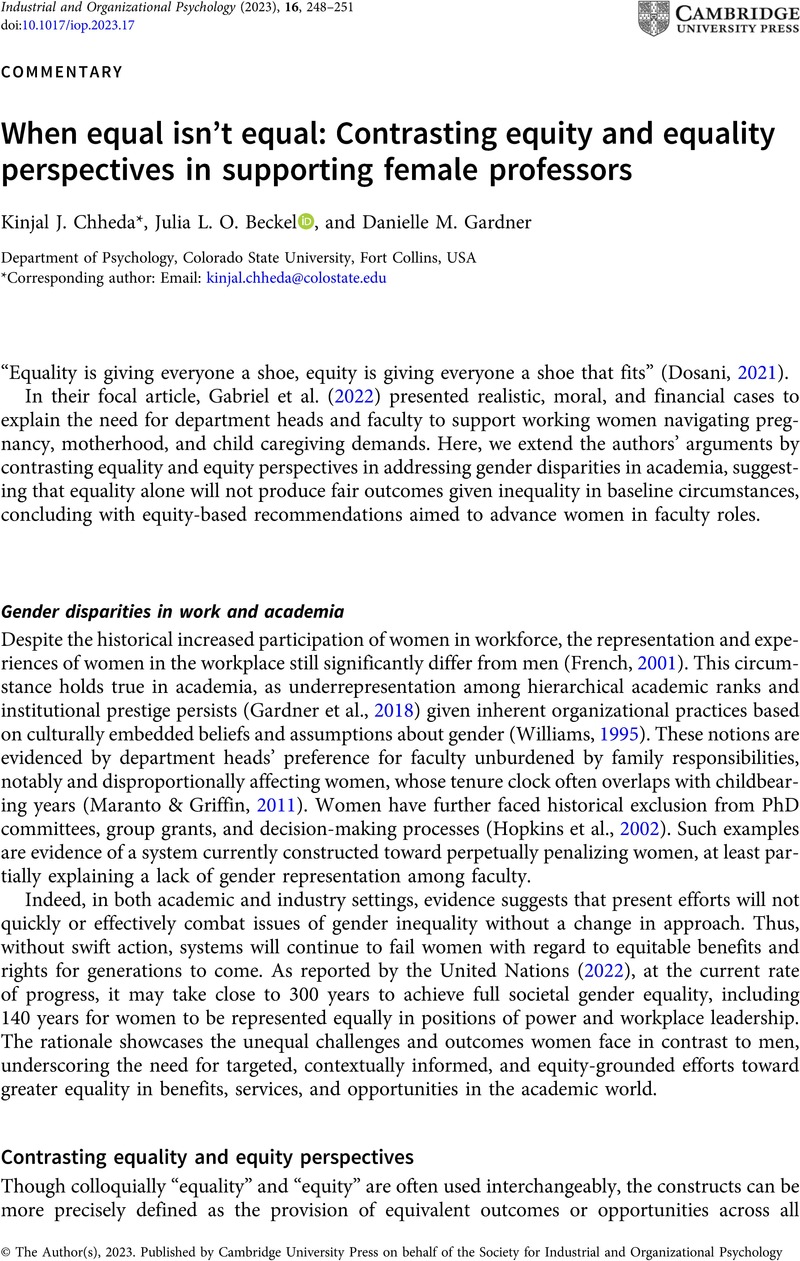No CrossRef data available.
Article contents
When equal isn’t equal: Contrasting equity and equality perspectives in supporting female professors
Published online by Cambridge University Press: 09 May 2023
Abstract
An abstract is not available for this content so a preview has been provided. Please use the Get access link above for information on how to access this content.

- Type
- Commentaries
- Information
- Copyright
- © The Author(s), 2023. Published by Cambridge University Press on behalf of the Society for Industrial and Organizational Psychology
References
Carlson, D. L., Petts, R. J., & Pepin, J. R. (2022). Changes in US parents’ domestic labor during the early days of the Covid-19 pandemic. Sociological Inquiry, 92(3), 1217–1244. https://doi.org/10.1111/soin.12459.CrossRefGoogle ScholarPubMed
Dosani, N. [@NaheedD]. (2021). Equality is giving everyone a shoe. Equity is giving everyone a shoe that fits. Justice is when we don’t need to give everyone a shoe because they can get their own shoe…a shoe that fits [Tweet]. Twitter. Retrieved from https://twitter.com/naheedd/status/1444343928908570640?lang=en)
Google Scholar
French, E. (2001). Approaches to equity management and their relationship to women in management. British Journal of Management, 12(4), 267–285. https://doi.org/10.1111/1467-8551.00210
CrossRefGoogle Scholar
Gabriel, A. S., Allen, T. D., Devers, C. E., Eby, L. T., Gilson, L. L., Hebl, M., Kehoe, R. R., … Rosen, C. C. (2022). A call to action: Taking the untenable out of women professors’ pregnancy, postpartum, and caregiving demands. Industrial and Organizational Psychology: Perspectives on Science and Practice, 16(2).Google Scholar
Gajendran, R. S., & Harrison, D. A. (2007). The good, the bad, and the unknown about telecommuting: Meta-analysis of psychological mediators and individual consequences. Journal of Applied Psychology, 92(6), 1524–1541.CrossRefGoogle ScholarPubMed
Gardner, D. M., Ryan, A. M., & Snoeyink, M. (2018). How are we doing? An examination of gender representation in industrial and organizational psychology. Industrial and Organizational Psychology: Perspectives on Science and Practice, 11(3), 369–388.CrossRefGoogle Scholar
Gilliland, S. W. (1993). The perceived fairness of selection systems: An organizational justice perspective. Academy of Management Review, 18(4), 694–734.CrossRefGoogle Scholar
Hopkins, N., Bailyn, L., Gibson, L., & Hammonds, E. (2002). The status for women faculty at MIT: An overview of reports from the schools of architecture and planning; engineering, humanities, arts and social sciences; and the Sloan School of Management. Retrieved from www.mit.edu/faculty/reports/overview.html.Google Scholar
Mann, S., & Holdsworth, L. (2003). The psychological impact of teleworking: stress, emotions, and health. New Technology, Work and Employment, 18(3), 196–211.CrossRefGoogle Scholar
Maranto, C., & Griffin, A. (2011). The antecedents of a “chilly climate” for women faculty in higher education. Human Relations, 64(2), 139–159.CrossRefGoogle Scholar
Pineault, L.A., Brumley, K., & Baltes, B. B. (2022). You work from home, I work from home, we all work from home: Differences in work family experiences by dyad-level work location configurations. Paper presented at the 37th Annual Conference of the Society for Industrial and Organizational Psychology, Seattle, WA.Google Scholar
United Nations. (2022). Progress on the sustainable development goals: The gender snapshot 2022. UN Women. https://www.unwomen.org/en/news-stories/press-release/2022/09/press-release-achieving-full-gender-equality-is-still-centuries-away-warns-the-united-nations-in-a-new-report
Google Scholar
Williams, C. (1995). Still a man’s world. Oakland, CA: University of California Press.CrossRefGoogle Scholar




